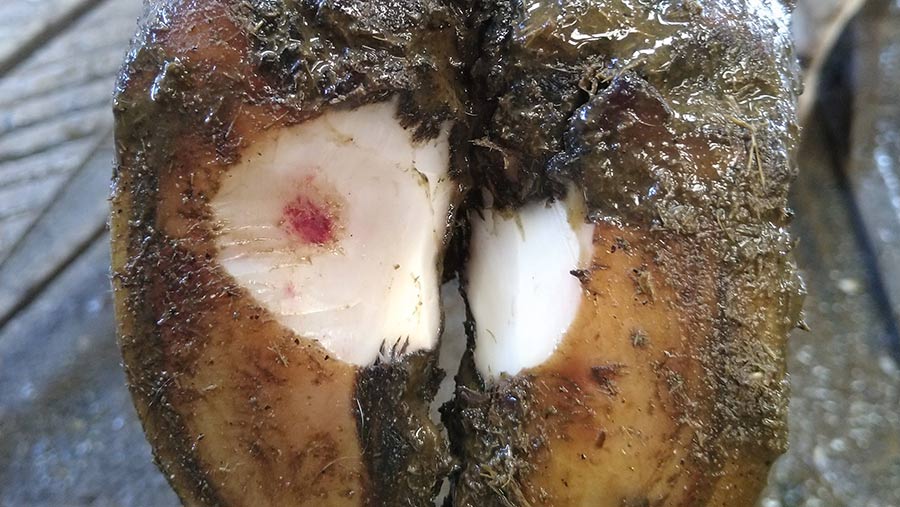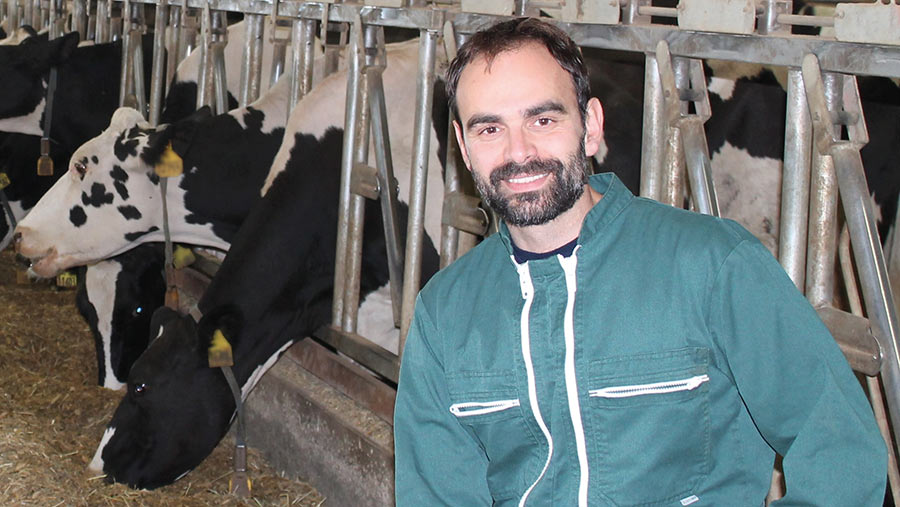Why genetics can play bigger role in breeding out lameness
 © Matthew Barden
© Matthew Barden Good husbandry, environment and nutrition all play a part in the fight against dairy cow lameness. But new research has found genetics has a bigger role than was previously thought.
The research, by the University of Liverpool, Scotland’s Rural College (SRUC) and the Royal Veterinary College, also shows that the UK’s genetic index for lameness – AHDB’s lameness advantage (LA) – can have a significant effect on eradicating the condition.
See also: How leg sensors helped get on top of lameness in dairy herd
It does this by reducing the tendency of cows to have the various causes of lameness, particularly sole ulcers and sole haemorrhage or bruising.
“Many existing studies have shown the heritability of lameness to be between 1% and 20%,” says University of Liverpool professor of cattle health and welfare Georgios Oikonomou.
Mr Oikonomou was a co-supervisor of this Biotechnology and Biological Sciences Research Council (BBSRC) initiative.

Georgios Oikonomou © Matthew Barden
These low estimates – also sometimes expressed as 0.01-0.20 – have raised doubts about how quickly and efficiently farmers could make improvements in lameness through breeding.
But the research demonstrated a far higher heritability for lameness, particularly for sole ulcers, at 0.35 (or 35%), and sole haemorrhage at 0.29 (or 29%).
This puts lameness on a par with most conformation traits, which are generally more easily measured.
Furthermore, by having a genomic index for LA calculated by AHDB for every animal involved in the trial, the researchers demonstrated that LA has a strong association with lameness later in life.
Genetic selection
In fact, the odds of a cow having sole ulcers declined by 32% for every point increase in LA in the animals taking part.
“To put this in context, a recent study reported a 20% reduction in the odds of a sole ulcer in cows that had been preventively foot-trimmed before drying-off,” said Prof Oikonomou, adding that foot-trimming was considered key in sole ulcer prevention.
“For this reason, we would advise producers to use LA as a genetic selection tool as part of sole ulcer and sole haemorrhage prevention,” he said.
“The cost of selecting high-LA sires is negligible in comparison with other interventions, which often include redesigning housing or increasing foot-trimming frequency.
“And the magnitude of the potential reduction in sole ulcer incidence that could be achieved through genetic selection would result in a substantial improvement in both animal welfare and farm efficiency.”
High-quality data
The researchers involved more than 2,000 dairy cows in their study, and recorded their lesions themselves, using the same trained vet for every cow.
This gave a better and more consistent measure of the cows’ phenotype (her actual physical looks or performance), and removed much of the so-called “noise”, which is created by other factors, including inconsistent scoring.
As a result, the researchers were able to create a higher-quality dataset than had previously been achieved.
Foot-trimming records
The trial showed the potential for reliable lameness records to be used for genetic selection to reduce the claw horn lesions, sole ulcers and sole haemorrhage.
“For genetic selection to work, we need big data,” says Prof Oikonomou. “The AHDB currently uses health data collected through milk recording in its calculation of LA, and that’s working really well.
“But this data can be incomplete or skewed towards the more severe causes of lameness. We can make the dataset even better by using foot-trimming records.”
For this reason, the team at Liverpool, together with the AHDB, have partnered with foot-trimmers through the National Association of Cattle Foot Trimmers and the Cattle Hoof Care Standards Board.
They are also collaborating with commercial software companies, including All4Feet, VetImpress and Hooftec, with the aim of facilitating access to foot-trimming data.
Their aim is to create one national database, merging different UK foot-trimmers’ records that will be used for the genetic evaluation of resistance to foot lesions.
“If we can get foot-trimming data from thousands of farms rather than hundreds, it will improve the quality of data and the effectiveness of LA,” he says.
However, the challenge has been to obtain formal consent for data-sharing, and he urges farmers to ask their foot trimmers or vets how they can give their consent.
“We have to get better with lameness as it’s a welfare and financial concern,” he says.
“It has to be tackled through better management, housing and diet, but if we can breed a more resistant cow, that gives us a head start.”
Targeting lameness
The lameness advantage score was developed by the AHDB in 2018, using records gathered on farm software and collected through milk recording.
It was included in the UK’s national breeding goal, profitable lifetime index (PLI), in 2019.
Marco Winters, AHDB head of animal genetics, says this means that selecting sires based on PLI will already help farmers reduce their cows’ tendency to be lame.
“However, if producers want to target lameness in particular, they should drill down through the components of PLI and make sure they choose a sire with a positive lameness advantage [LA] score,” he says.
“The Liverpool study has shown that for every two-point decline in lameness advantage, the risk of sole ulcer doubles,” he says. “This shows how effective it can be to breed for LA.”
“However, the study also demonstrates the benefits of more data and more consistency of data, which means using foot-trimmer records.
“We urge farmers to give consent for the use of their data, as this will make the LA score more effective and allow them to breed a natural resistance to lameness more quickly into their cows.”
Sole ulcers and sole haemorrhage
Sole ulcers
A sole ulcer is an area of damaged sole horn that has completely lost the horn tissue except for the corium (the tissue that produces new sole horn).
It occurs when the structures supporting the pedal bone within the hoof weaken.
The bone can then move and sink, causing damage to the horn. As the sole wears, the area of damaged horn is exposed, leading to the development of an ulcer.
Sole haemorrhage
Sole haemorrhage, or sole bruising, is characterised by red and sometimes yellow marks or areas on the sole, and may occur where the sole is particularly thin.
It is caused by pressure on the corium, leading to damage to cells and blood vessels.
Inflammatory chemicals can cause permanent changes to the pedal bone, and possibly the digital cushion, leading to further episodes of bruising.
Sole haemorrhage is the usual precursor to sole ulcers.
Source: AHDB
